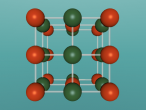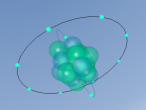This blog focuses on the silicon atom. It details the composition, structure and characteristics, as well as the many ways in which humans use and depend upon this element. Furthermore, this entry will retell a short history of the silicon atom, from its initial creation, to its discovery, until now. Finally, the blog will give an overview of the process involved in the creation and programming of this atom model below, via VRMath2 software.
Here is the atom:
Silicon is a stable metalloid element with an atomic number of 14. It has an atomic weight of 28.085 amu and is in the elemental group 'carbon', meaning that it is not radioactive. Silicon cannot lose or gain electrons to form ions, however it can share to form covalent bonds with nonmetals (such as oxygen in SiO2), another trait characteristic of the 'carbon' group. Interestingly, silicon expands as it freezes, a trait shared with water. Silicon, or Si, was discovered in 1824 by Jöns Berzelius, and has since been utilised in many different ways from machine tools to hair conditioners. The name is derived from the Latin 'silicis', or 'silex', meaning flint. Its melting and boiling points are 1687K and 3538K respectively, thus silicon is a solid at room temperature. Two allotropes of silicon exist, amorphous Si and crystalline Si, however any form of pure silicon is extremely rare in nature. Silicon is one of the most useful elements to humans. Alloys such as aluminium-silicon and ferry-silicon (iron silicon) are used to manufacture dynamo and transfer plates, engine blocks, cylinder heads, machine tools and to deoxidise steel. Silicones, which are silicon-oxygen polymers with methyl groups attached, can be used as an oil in cosmetics and hair conditioners, and rubber as a waterproofing sealant for bathrooms, pipes, etc. Hyperpure silicon is used for its semiconductive properties in computers and microelectronics. Silicon dioxide is used to make glass and bricks. Silicon carbide (SiC), which is nearly as hard as diamond, is used as an abrasive. Sodium silicate (Na2SiO3) is used to manufacture soaps and as an adhesive. Sodium tetrachloride (SiCl4) is used to make smoke screens.
Silicon, in its purest form, has 14 electrons, protons, and neutrons. However, it can exist in other forms, or isotopes, where there is a different number of neutrons. This has no impact on the charge of the atom, as the neutrons themselves have no charge. The only stable isotopes are Si 28, 29 and 30, though there are 20 known radioisotopes. As can be seen in the model above, the element has three electron shells. The first two shells are full, with 2 and 8 electrons respectively, but the third shell fills only 4 of the 8 possible slots, as demonstrated in the electron configuration [Ne]3s23p2. These four electrons are less stable valence electrons, meaning that they can be lost, shared or exchanged with other atoms. Despite this, silicon is a very stable atom, and thus is the second most common element in the earths crust (about 28% by mass), after oxygen.
While silicon is the second most abundant element on the Earth's crust, it very rarely exists in its pure form. Instead, it bonds with other elements to form molecules and compounds, most commonly silicon-oxides and silicates. Silicon is a very versatile atom because of its tetrahedral form, meaning that it can form strong stable bonds with other atoms. The most common compound of silicon, and the most abundant compound in the Earth's crust, is silicon dioxide, or SiO2, which is commonly found in sand. Other examples of materials made up of silicon oxides are quartz, rock crystal, amethyst, agate, flint and opal. The most common silicates are neosilicates, sorosilicates, cyclosilicates, inosilicates, phyllosilicates, and tectosilicates. These silicate compounds form minerals such as olivine, beryl, pyroxenes, talc, quartz, granite, hornblend and many more. Altogether, these silicate minerals account for 90% of the mass of the Earth's crust.
The model seen above it that of a single silicon atom. It was made using VRMath2 programming, a versatile program which can be used to create stationary and motion models of 2D and 3D shapes and designs. Thus, a further design that could be explored is that of a particular molecule or compound. To link this with the silicon model, a good compound to program would be silicon dioxide. While the coding language we used through VRMath2 was quite simple, my lack of experience in programming meant that some tasks were difficult. For example, initiating a simulation of the electron orbital patterns proved a complicated task because it involved setting up several objects, such as the orbital ring, as the "parent objects" of others, such as the electrons themselves. This causes the electrons to rotate with the ring itself. In addition to this, the electron rings had to rotate on multiple axes, meaning that two lines of programming had to be written, with care taken to ensure that they did not interfere with each other. Finally, the configuration of silicon requires 14 electrons, neutrons, and protons. To individually place each of these subatomic particles in the correct positioning would be a tedious and time consuming process. Thus, a solution was devised to minimise time placing individual spheres to represent the subatomic particles. Repeat systems were set up, meaning that a command was repeated a set amount of times. For example:
Repeat 8 [ up 2 sphere down 2 rightturn 45 ]
This meant that only one line of coding was required to set up all the electrons in any particular shell, and this principle was also applied to the protons and neutrons in the nucleus. The full coding is shown below, should you like to view it.
Thanks for reading! I hope you found this interesting, and that you learnt something from it.
(Read on for some extra info)
Here is the full coding for the silicon atom seen above:

Here is a link to the VRMath2 program, if you want to experiment:
https://vrmath2.net/VRM2/
For more information on silicon, visit:
http://chemwiki.ucdavis.edu/Core/Inorganic_Chemistry/Descriptive_Chemistry/Elements_Organized_by_Block/2_p-Block_Elements/Group_14%3A_The_Carbon_Family/Chemistry_of_Silicon
Or:
https://www.webelements.com/silicon/






















